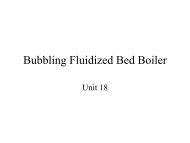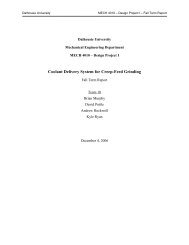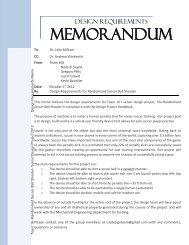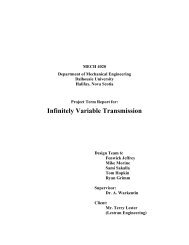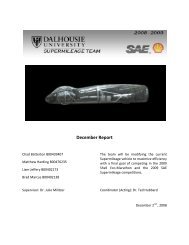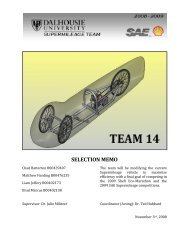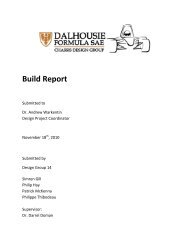Final Design Report - Dalhousie University
Final Design Report - Dalhousie University
Final Design Report - Dalhousie University
You also want an ePaper? Increase the reach of your titles
YUMPU automatically turns print PDFs into web optimized ePapers that Google loves.
<strong>Final</strong> <strong>Design</strong> <strong>Report</strong><br />
Submitted to<br />
Dr. Darrel Doman<br />
<strong>Design</strong> Project Supervisor<br />
April 8 th , 2011<br />
Submitted by<br />
<strong>Design</strong> Group 14<br />
Simren Gill<br />
Philip Hay<br />
Patrick McKenna<br />
Philippe Thibodeau
Table of Contents<br />
Table of Contents ........................................................................................................................................... i<br />
List of Figures ................................................................................................................................................ ii<br />
List of Tables ................................................................................................................................................. ii<br />
1.0 Introduction ...................................................................................................................................... 1<br />
2.0 Background Information ................................................................................................................... 1<br />
3.0 Problem Definition ............................................................................................................................ 1<br />
4.0 Project Scope .................................................................................................................................... 2<br />
5.0 <strong>Design</strong> Requirements ........................................................................................................................ 2<br />
5.1 Constraints .................................................................................................................................... 2<br />
5.2 Criteria........................................................................................................................................... 3<br />
6.0 <strong>Final</strong> <strong>Design</strong> ....................................................................................................................................... 3<br />
7.0 Frame Testing .................................................................................................................................... 4<br />
7.1 Formula SAE Rules ........................................................................................................................ 5<br />
7.2 Driver Ergonomics ......................................................................................................................... 6<br />
7.3 Driver Egress ................................................................................................................................. 7<br />
7.4 Engine Removal ............................................................................................................................. 8<br />
7.5 Torsional Stiffness ......................................................................................................................... 8<br />
8.0 Suspension ...................................................................................................................................... 10<br />
8.1 Hubs ............................................................................................................................................ 11<br />
8.2 Uprights ....................................................................................................................................... 11<br />
8.3 Springs and Dampers .................................................................................................................. 13<br />
8.4 Anti-Roll Bar ................................................................................................................................ 14<br />
8.5 Bellcranks .................................................................................................................................... 14<br />
9.0 Steering ........................................................................................................................................... 15<br />
10.0 <strong>Design</strong> Requirements Summary ...................................................................................................... 16<br />
11.0 Additional Achievements ................................................................................................................ 17<br />
12.0 Conclusion ....................................................................................................................................... 17<br />
References .................................................................................................................................................. 18<br />
i
List of Figures<br />
Figure 1: Formula SAE Chassis ...................................................................................................................... 4<br />
Figure 2: <strong>Final</strong> Frame <strong>Design</strong> ......................................................................................................................... 5<br />
Figure 3: Formula SAE Templates ................................................................................................................. 6<br />
Figure 4: Driver Ergonomics .......................................................................................................................... 6<br />
Figure 5: Head Clearance Ruling ................................................................................................................... 7<br />
Figure 6: Torsional Stiffness Experiment Setup ............................................................................................ 9<br />
Figure 7: Suspension System ....................................................................................................................... 10<br />
Figure 8: Rear Hubs ..................................................................................................................................... 11<br />
Figure 9: Upright Size Comparison .............................................................................................................. 12<br />
Figure 10: Detailed Upright Views .............................................................................................................. 13<br />
Figure 11: Anti-roll bar setup ...................................................................................................................... 14<br />
Figure 12: Rear suspension assembly ......................................................................................................... 15<br />
List of Tables<br />
Table 1: <strong>Final</strong> <strong>Design</strong> Summary ..................................................................................................................... 3<br />
Table 2: Driver Egress Results ....................................................................................................................... 8<br />
Table 3: Experiment Results.......................................................................................................................... 9<br />
Table 4: <strong>Design</strong> Requirements Summary .................................................................................................... 16<br />
ii
1.0 Introduction<br />
The purpose of this report is to provide a final summary of the Formula SAE Chassis <strong>Design</strong> Group’s<br />
design project. This document will present an overview of the project, the project scope, and the<br />
design requirements for this project, while outlining the selected final design. The design group’s<br />
final design will then be detailed, with a strong focus on testing and unique design features of the<br />
three subsystems. This report will also contain a detailed team budget. The Formula SAE Chassis<br />
<strong>Design</strong> Group is pleased with the results of the project, and believes that the vehicle chassis will<br />
provide a solid foundation for future <strong>Dalhousie</strong> Formula SAE cars. Each system has been designed<br />
for maximum adjustability so that systems can be fine-tuned during vehicle testing, with focus on<br />
reliability, weight reduction, manufacturing, and universally compatible parts.<br />
2.0 Background Information<br />
Formula SAE is an international collegiate student design competition organized by the Society of<br />
Automotive Engineers (SAE) International (SAE International, 2010). The competition in Detroit,<br />
Michigan attracts over 1400 students from more than 120 universities and colleges from around<br />
the world (SAE International, 2010). The premise behind Formula SAE is that each student-run<br />
group has been approached by a fictitious manufacturing company to develop a small formula-style<br />
race car (SAE International, 2010). SAE International outlines strict rules and regulations to ensure<br />
competition and vehicle safety.<br />
3.0 Problem Definition<br />
The objective of this project is to design and construct a chassis for the <strong>Dalhousie</strong> Formula SAE<br />
team. The design group has been approached by the <strong>Dalhousie</strong> Formula SAE team to complete this<br />
project in time for the upcoming 2011 Formula SAE competition in Detroit, Michigan. There is a<br />
strong need for this project, as the 2011 Formula SAE Rules state that teams wishing to compete on<br />
a yearly basis must have, as a minimum, a new frame for their vehicle each year (Society of<br />
Automotive Engineers, 2011). The design group has enthusiastically accepted this challenge and a<br />
full description of the scope of the project and the components that constitute the chassis can be<br />
found in Section 4.0.<br />
1
4.0 Project Scope<br />
The chassis is an integral part of a formula-style race car; encompassing the frame, suspension,<br />
steering, and hub and upright assemblies. For this project, the chassis is defined as including all<br />
frame members, with the forward vehicle limit being the front bulkhead, and the rear vehicle limit<br />
being the differential mounts. All mounting tabs other than those for the suspension and the engine<br />
are outside of the scope of this project. With regards to the suspension, wheel and brake selection<br />
are excluded. Steering will also be included as part of the chassis for this project. The project scope<br />
will include design selection, use of modeling tools and simulation, iterative design refinement, and<br />
construction of the final design.<br />
5.0 <strong>Design</strong> Requirements<br />
In order to select the final design of our project, the group has created several design requirements<br />
which have been divided into constraints and criteria. These design requirements are a<br />
combination of rules and self-set goals to improve upon the chassis of last year’s vehicle and the<br />
success of the design group will be based on being able to effectively meet these requirements.<br />
5.1 Constraints<br />
The following requirements must be followed in the design of the chassis. If any of these<br />
requirements are not met, the design will be considered unsuccessful.<br />
General<br />
� Must meet all Formula SAE requirements, as outlined in the 2011 Formula SAE Rules.<br />
� Must ensure the safety of the driver at all times.<br />
Frame<br />
� Weight of frame must be 75 lbs or less.<br />
� All four design group members must be able to exit from the vehicle in 4.5 seconds.<br />
� Must demonstrate improved driver ergonomics; this will be done by ensuring that the<br />
driver’s hips are 5 inches or less below the ankles while in the cockpit.<br />
Suspension<br />
� 10% reduction in wheelbase length from last year’s design.<br />
� 25% reduction in steering ratio from last year’s design.<br />
� Turning radius must be less than 15 feet.<br />
2
5.2 Criteria<br />
The following requirements should be followed in the design of the chassis. These criteria are not<br />
critical to the success of the chassis, however they will enhance performance.<br />
Frame<br />
� Strengthen the frame by minimizing the number of bends.<br />
� Improve engine packaging to allow for a removal time of less than two hours and eliminate<br />
the need of dismantling the suspension before removing the engine from the frame.<br />
Suspension<br />
� Include anti-roll bars as part of the suspension design.<br />
� Reduce size of uprights to eliminate contact with wheel.<br />
6.0 <strong>Final</strong> <strong>Design</strong><br />
The Formula SAE rules were used as strict guidelines throughout the design process to ensure the<br />
safety and eligibility of the chosen final design. To select the final design, the design group divided<br />
the chassis into subsystems: the frame, the suspension, and the steering. After subjecting each<br />
subsystem to the design process outlined in the <strong>Design</strong> Selection <strong>Report</strong>, a final design was chosen<br />
based on the design requirements in Section 5.1 and Section 5.2. Table 1 shows the final design for<br />
each subsystem while Figure 1 shows the final design of the chassis. It is extremely important to<br />
note that all systems were designed simultaneously, as changes in one subsystem can drastically<br />
affect the design of another subsystem. The following sections will further explore each subsystem.<br />
Table 1: <strong>Final</strong> <strong>Design</strong> Summary<br />
Subsystem <strong>Final</strong> <strong>Design</strong><br />
Frame<br />
o Construction Steel Spaceframe<br />
o Manufacturing VR3 Engineering Ltd. Cartesian Tube Profiling<br />
o Materials<br />
4130 Cr-Mo<br />
Suspension<br />
o Construction<br />
o Manufacturing<br />
o Materials<br />
Steering<br />
o Construction<br />
o Manufacturing<br />
o Materials<br />
Non-Equal and Non-Parallel Wishbones<br />
<strong>Dalhousie</strong> <strong>University</strong> & Velocity Machining<br />
4340/4130/1018 Steel &7075-T6 Aluminum<br />
Front Wheel Steering System with Rack & Pinion<br />
<strong>Dalhousie</strong> <strong>University</strong><br />
4130 Steel<br />
3
Figure 1: Formula SAE Chassis<br />
7.0 Frame Testing<br />
The frame has been constructed using a steel space frame design. The ease of manufacturability,<br />
rigid structural Formula SAE guidelines (eliminating the need for material testing) and the reduced<br />
cost of the steel were the primary benefits that resulted in the selection of the steel space frame. For<br />
a full discussion on the material and manufacturing selections, please see <strong>Design</strong> Group 14:<br />
December <strong>Design</strong> <strong>Report</strong>. Figure 2 shows the constructed frame.<br />
One of the main criteria for the frame was weight. Having a light frame is very important as a<br />
lighter car allows for faster acceleration, better handling and more efficient fuel consumption. The<br />
team aimed for a frame weight of 75 lbs or less and produced a frame weighing 65 lbs. This was<br />
accomplished through careful consideration of member placement and component packaging. The<br />
frame and suspension were designed simultaneously so that reinforced nodes on the frame<br />
corresponded to suspension arm nodes. This ensured that no frame member was put into bending<br />
or compression.<br />
4
Figure 2: <strong>Final</strong> Frame <strong>Design</strong><br />
Proper design of the frame and suspension also allowed for the frame to be designed so that the<br />
Formula SAE ruling of minimum ground clearance (1” from ground to frame) was achieved. This<br />
allows for a lower vehicle center of gravity (CG) which is important for handling and turning in<br />
many dynamic vehicle events at the Formula SAE competition. The number of bends was also<br />
minimized to only those required by the main and front roll hoops. This was an improvement over<br />
past <strong>Dalhousie</strong> Formula SAE vehicles, and this reduction was important as bends weaken the frame.<br />
7.1 Formula SAE Rules<br />
The Formula SAE rules provide strict guidelines which must be adhered to for the frame to be able<br />
to compete in the events. There are several templates which must be able to pass through all points<br />
of the frame to ensure adequate spacing for the driver. Figure 3 shows both the cockpit internal<br />
cross section template and the cockpit opening template being able to pass through the frame.<br />
Another template is used to ensure that the 95 th percentile male will be able to fit inside the cockpit.<br />
5
These templates ensure that the frame is able to fit drivers of all sizes, and ensures that the driver is<br />
comfortable, can easily access controls, and can easily enter and exit the vehicle.<br />
Figure 3: Formula SAE Templates<br />
7.2 Driver Ergonomics<br />
One of the design requirements that the design team implemented was to improve driver<br />
ergonomics. Based on an ergonomics study done by the Formula SAE team, it was determined that<br />
this would be accomplished by ensuring that the driver’s hips are 5 inches or less below the ankles<br />
while in the cockpit. Figure 4 shows how the new frame meets this requirement as the ankles are<br />
nearly in line with the hips with one of the group members in the frame in the driving position.<br />
Figure 4: Driver Ergonomics<br />
6
Another Formula SAE rule that was met was the minimum spacing of the driver’s helmet to the<br />
main roll hoop, which is required to be a minimum of 2 inches. By creating several mock-ups and<br />
using the <strong>Dalhousie</strong> Formula SAE team’s driver ergonomics data, the team was easily able to meet<br />
this ruling with a 4 inch clearance with the tallest driver on the team. Figure 5 shows the final<br />
frame design with the design group being able to meet this Formula SAE requirement.<br />
Figure 5: Head Clearance Ruling<br />
To further improve driver ergonomics, the <strong>Dalhousie</strong> Formula SAE team also purchased a Tillett<br />
W3 formula-style racing seat from Tillett Racing Seats in order to provide the driver with a<br />
comfortable position, vehicle feedback, and proper support. The purchase of the racing seat was<br />
taken into consideration when designing the frame and creating frame mock-ups to ensure proper<br />
spacing. The angle of the seat back is approximately 45°, which is within the range of 30° to 50°<br />
that was found to be the most comfortable during the ergonomics study. The frame mock-ups also<br />
helped to ensure that the steering wheel and pedal assembly were positioned appropriately for<br />
drivers with heights between 5’4” and 6’3”.<br />
7.3 Driver Egress<br />
Formula SAE rules state that driver must be able to exit the vehicle in under 5 seconds. The design<br />
team has targeted an egress time of under 4.5 seconds for each group member to exit the vehicle. A<br />
faster egress time is directly linked to driver ergonomics, along with frame design. The side of the<br />
cockpit was designed so that it is lower at the point where the driver would exit the vehicle, making<br />
7
it easier for egress. To test this deliverable, each group member was placed in the vehicle and the<br />
time to exit was recorded. This was done five times for each group member. Table 2 shows the<br />
results.<br />
Table 2: Driver Egress Results<br />
Group Member Average Time (secs)<br />
Simren Gill 2.70<br />
Phil Hay 3.29<br />
Patrick McKenna 3.36<br />
Phil Thibodeau 3.39<br />
As can be seen from Table 2, the design group was able to meet the established time requirement.<br />
However, since the method of egress used by the design group is not identical to that of the actual<br />
vehicle scenario, it has been determined that this design requirement was not fully met. The final<br />
seat location must be determined by the Formula SAE team, and the body side pods will also be<br />
attached to the frame. As an initial test, based on the results listed above, it appears that the<br />
<strong>Dalhousie</strong> Formula SAE team should have no problem with meeting the 5 second egress time.<br />
7.4 Engine Removal<br />
One of the criteria for this project was to improve engine removal time. Last year’s engine removal<br />
time was over two hours, and this was due mainly to the fact that the suspension needed to be<br />
removed first in order to remove the engine. This year, a sub-frame was created around the engine,<br />
which allows for the engine to be easily removed by unbolting the engine from the frame and lifting<br />
the frame up and out of the way for engine access. The suspension does not have to be removed to<br />
access the frame, which results in quick access to the frame, which is important if quick<br />
adjustments to the frame are required.<br />
7.5 Torsional Stiffness<br />
The torsional stiffness of the frame was experimentally calculated to ensure the frame has the<br />
necessary rigidity to successfully perform in the Formula SAE competition. The torsional stiffness<br />
was calculated by fixing the rear of the frame and placing a weight of 250 Newtons on one end of<br />
the frame. The deflection of the frame under the weight was calculated using digital micrometers<br />
at each side of the frame members. This was done for each side of the frame at two different<br />
locations: the half length (from the main roll hoop to the front roll hoop) and the full length (from<br />
the main roll hoop to the front bulkhead). The experiment was done 5 times to ensure accuracy<br />
8
and repeatability of the results. Figure 6 shows the experiment setup while Table 3 shows the<br />
results of the test.<br />
Figure 6: Torsional Stiffness Experiment Setup<br />
Table 3: Experiment Results<br />
Weight Location Average Stiffness Value (N/m)<br />
Half Length 2060<br />
Full Length 1675<br />
These results compare favourably with most Formula SAE vehicle results and vehicle of this size,<br />
along with the design team’s computer simulation results. Typical values for torsional stiffness are<br />
in the range of 1500 – 2500 N/m, therefore the frame is within this range and it can be concluded<br />
that the frame is a bit soft (SAE International, 2010). The Formula SAE team is pleased with these<br />
results and it is believed that it is strong enough to effectively perform at the competition, while at<br />
the same time being able to absorb vibrations.<br />
9
8.0 Suspension<br />
A pushrod suspension was selected based on the wide range of adjustability and packaging options<br />
that it provides. The suspension arms incorporate threaded rod ends, which allows for fine tuning<br />
of the arms. In addition, the ability to adjust ride height and vehicle stance without affecting the<br />
spring preload and the wide range of potential motion ratios are advantages of this suspension<br />
type. An iterative design process was used such that the suspension mounts corresponded to nodes<br />
on the frame, establishing properly triangulated load paths. Figure 7 shows the full suspension<br />
assembly.<br />
Figure 7: Suspension System<br />
The final wheelbase was determined to be 1545 mm (61 in) which proves to be an 11% reduction<br />
from the 2010 <strong>Dalhousie</strong> Formula SAE car. This exceeds the design team’s constraint of having a<br />
10% reduction in wheelbase. The final front track width is 1200 mm (47 in), while the rear track<br />
width is 1155 mm (45.5 in), both of which are reductions from the 2010 vehicle. It is anticipated<br />
that the relatively short wheelbase and wide front track width will result in a vehicle that is well<br />
suited for the tight corners seen in the autocross and endurance events. The ride height of the<br />
vehicle was chosen to be 1¼” as this provides a low CG and accommodates any track irregularities.<br />
10
8.1 Hubs<br />
The hubs needed to be redesigned as the Formula SAE team purchased new 13” OZ racing wheels<br />
and the new hubs have been designed to mate with these wheels. A floating hub design was<br />
selected over a fixed hub design as this allowed for more design freedom and eliminated the need<br />
for splines, simplifying and reducing the overall weight of the design. Finite Element Analysis was<br />
used to confirm the hub material as 4340 steel and to ensure the design could withstand the torque<br />
applied by both the wheels and the brakes. The hubs are attached to the wheel using a single<br />
anodized lock nut. A C-V joint is integrated with the rear hub as this reduces the overall number of<br />
parts for the vehicle. Figure 8 shows a picture of the rear hubs.<br />
Figure 8: Rear Hubs<br />
8.2 Uprights<br />
Based on the finite element analysis conducted last semester, it was determined that the uprights<br />
could be reduced in weight and overall size compared to the uprights of last semester (Gill, 2010)<br />
(McKenna, 2010). The design team was able to successfully incorporate these changes and Figure 9<br />
shows a comparison between the new and old upright in the wheel. With the new upright design,<br />
the design team is confident that interference between the upright and the wheel will not be an<br />
issue.<br />
11
Figure 9: Upright Size Comparison<br />
One of the main features of the new upright design is that they have been designed to be universally<br />
compatible. This is a design departure from former Formula SAE teams. In the past, due to the<br />
Formula SAE rules that the frame must be redesigned each year, every component of the vehicle<br />
was being redesigned year after year. These uprights have been designed so that they can be<br />
reused year after year, saving the Formula SAE team time, money, and manufacturing, as the<br />
uprights are a very complex part.<br />
To make the uprights universally compatible, adapter plates were designed to be attached to the<br />
uprights. These adapter plates are the only component that requires redesigning year after year as<br />
the adapter plates dictate the location of the suspension mounting points on the upright. Due to the<br />
Formula SAE ruling that the frame must be redesigned year after year, this means that the<br />
suspension geometry will change as well, resulting in the location of only the adapter plate needing<br />
to be redesigned each year, with the upright being able to be reused year after year. Figure 10<br />
shows four different views of the uprights. On the left is the upright by itself, while the next two<br />
images show the front and rear uprights with their respective adapter plates. The final image on<br />
the right is a side view of the upright. As can be seen, shims were designed and added in between<br />
the upright and the adapter plates. By adding or removing the number of shims, the amount of<br />
camber can be adjusted, which allows the camber to be quickly fine tuned during full vehicle<br />
12
testing. To date, the uprights have been set with a static camber of 1.5 degrees, which was the set<br />
target to achieve during the initial design.<br />
Figure 10: Detailed Upright Views<br />
8.3 Springs and Dampers<br />
Spring rates were calculated based on a target roll rate of 1.1 degree/g. This was done by<br />
determining the lateral acceleration of the vehicle during cornering, the weight distribution of the<br />
vehicle, and with the use of motion ratios (wheel to spring travel) (Milliken & Milliken, 1995).<br />
From these calculations, 250 lb/in springs were required in the front of the vehicle, and 350 lb/in<br />
springs were required in the rear. The difference in spring stiffness between the front and rear of<br />
the vehicle is due to weight distribution, as the bulk of the weight is in the rear of the vehicle<br />
(engine and related components).<br />
With regards to dampers, Penske 7800 double adjustable dampers were selected. These dampers<br />
were valved according to the calculated damping curve, based on vehicle parameters. These<br />
dampers can also be easily adjusted to fine tune the suspension system, which will be extremely<br />
useful during full vehicle testing.<br />
13
8.4 Anti-Roll Bar<br />
One of the design constraints was to incorporate an anti-roll bar in the suspension system. This<br />
was accomplished as an anti-roll bar was able to be installed in the rear of the vehicle. The anti-roll<br />
bar was designed to provide the additional stiffness required to achieve the target roll rate of 1.1<br />
degrees/g (Milliken & Milliken, 1995). Moment arm lengths were calculated based on the<br />
maximum bending force applied and the stiffness of the anti-roll bar. The moment arms were made<br />
with slots so that the moment arm length can be adjusted and tuned for peak performance and<br />
handling. The anti-roll bar is attached to the bellcranks and is packaged in the rear of the vehicle<br />
with no interference with any of the other suspension components. Figure 11 shows the anti-roll<br />
bar.<br />
Figure 11: Anti-roll bar setup<br />
8.5 Bellcranks<br />
The bellcrank transmit the forces from the tires to the springs, dampers, and anti-roll bar through<br />
the pushrods. These pushrods have a left hand rod end on one end, and a right hand rod end on the<br />
other, which allows the height of the pushrods to be easily adjusted. This is important as it allows<br />
for easy changing of the vehicle ride height. The bellcrank design allows for all these components<br />
to be attached to the bellcrank, with the bellcrank rotating about a fixed axis to provide the transfer<br />
of forces. Figure 12 shows the rear suspension setup of the vehicle with the major components<br />
labelled.<br />
Anti-Roll Bar<br />
Moment Arm<br />
14
Pushrod<br />
Figure 12: Rear suspension assembly<br />
9.0 Steering<br />
The steering system has been designed to allow for maximum adjustability with the steering arm.<br />
The easily replaced steering arm allows the team to test and tune the Ackermann, steering effort,<br />
and total steering ratio.<br />
One of the design constraints of the steering system was to reduce the turning radius to less than 15<br />
feet. The design group performed a low speed turning test, measuring the turning radius by<br />
moving the vehicle in a circular path. This experiment was repeated five times for repeatability and<br />
reliability purposes and the average turning radius obtained was 13.4 feet. This low turning radius<br />
will allow the vehicle to handle much better and take corners much better in the dynamic racing<br />
events at the Formula SAE competition.<br />
Shocks<br />
Bellcranks<br />
Anti-Roll Bar Assembly<br />
The other main design goal with regards to the steering is reduce the steering ratio by 25% from<br />
last year’s vehicle. The lock-to-lock steering wheel motion was measured to be 235 degrees, which<br />
results in a 35% reduction in steering ratio. This improved steering ratio is desirable, as it<br />
15
eliminates the driver performing hand-over-hand driving, which can be troublesome during quick<br />
turning events.<br />
10.0 <strong>Design</strong> Requirements Summary<br />
Table 4 summarizes the design group’s design requirements and the success in meeting these<br />
requirements.<br />
Table 4: <strong>Design</strong> Requirements Summary<br />
CONSTRAINTS<br />
System Requirement Requirement Met<br />
Frame Weight must be under 75 lbs YES<br />
Improved egress NO<br />
Improved ergonomics YES<br />
Suspension 10% reduction in wheelbase YES<br />
25% reduction in steering ratio YES<br />
Turning radius of under 15 feet YES<br />
CRITERIA<br />
Frame Minimize bends YES<br />
Improve engine packaging YES<br />
Better integration of suspension<br />
nodes<br />
YES<br />
Suspension Incorporate anti-roll bar YES<br />
Reduce overall upright size YES<br />
As can be seen, 10 of the 11 design requirements have been met. With regards to the driver egress,<br />
all team members were able to exit the vehicle in under 4.5 seconds; however since the seat mounts<br />
and harness were not installed in time by the Formula SAE team, testing method was not identical<br />
to the real case scenario. Based on the results obtained, the design group is confident that full<br />
egress tests will yield results of under 4.5 seconds.<br />
16
11.0 Additional Achievements<br />
The following is a summary of features that were not design requirements but were included in the<br />
overall design of the chassis which have helped to enhance the overall design:<br />
� Universally compatible uprights<br />
� Adjustable camber with shims<br />
� Integrated C-V joints in rear hubs<br />
� Adjustable anti-roll bar<br />
� Adjustable steering arms<br />
� Can fit inside a standard pickup truck<br />
12.0 Conclusion<br />
In conclusion the design team met 10 of the 11 constraints. The one constraint that was not met<br />
was that for egress, as the Formula SAE team had not finalized their mounting for the seat. With<br />
this design, the team is confident that the egress target can be met once the seat is installed. The<br />
chassis will be integrated with the powertrain and other vehicle components and the whole vehicle<br />
will be tested in the upcoming weeks. The chassis is competition ready, and the vehicle will be<br />
competing in Detroit, Michigan this summer.<br />
17
References<br />
Auto-ware. (2010). Retrieved 9 2010, from Auto-Ware's Racing and Performance Tech Site:<br />
www.auto-ware.com<br />
Blundell, M., & Harty, D. (2004). Multibody Systems Approach to Vehicle Dynamics. New York:<br />
Elsevier.<br />
Car Theory. (2010). Car Theory. Retrieved October 16, 2010, from RC Car Seminar:<br />
http://www.rccarseminar.com/index.php?menutopic=Home&submenu=Home&hmenustr=Car%2<br />
0Theory<br />
Cartesian. (2010). Retrieved September 11, 2010, from Cartesian Tube Profiling:<br />
www.cartesiantube.com<br />
Crolla, D. A. (2009). Automotive Engineering: Powertrain, Chassis and Vehicle Body. Burlington:<br />
Elsevier.<br />
<strong>Design</strong> Group 14. (2010). <strong>Design</strong> Requirements Memo. Halifax.<br />
Formula Student. (2010). Public Relations. Retrieved October 22, 2010, from News:<br />
http://www.formulastudent.de/public-relations/fsg-news/news-details/article/steves-box-oftricks/<br />
Fox, S. (2010). Cockpit Control Forces. Warrendale: Chief <strong>Design</strong> Judge - Formula SAE.<br />
Gill, S. (2010). 2010-2011 Formula SAE Upright Analysis. Halifax.<br />
Gillespie, T. G. (1992). Fundamentals of Vehicle Dynamics. Warrendale: SAE International.<br />
Harris, W. (2010). How Car Suspensions Work. Retrieved October 18, 2010, from HowStuffWorks:<br />
http://auto.howstuffworks.com/car-suspension4.htm<br />
Matweb. (2010). Retrieved September 12, 2010, from Online Materials Information Resource:<br />
www.matweb.com<br />
McKenna, P. (2010). 2009-2010 Formula SAE Upright Analysis. Halifax.<br />
Milliken, W. F., & Milliken, D. L. (1995). Race Car Vehicle Dynamics. Warrendale: SAE International.<br />
Motor Era. (2010). Retrieved November 9, 2010, from http://www.motorera.com/<br />
OptimumK. (2010). Retrieved October 14, 2010, from www.optimumg.com<br />
Rack and Pinions. (2010). Retrieved 10 20, 2010, from Woodward Steering:<br />
http://www.woodwardsteering.com/<br />
Reimpell, J., Stoll, H., & Betzler, J. (2001). The Automotive Chassis: Engineering Principles.<br />
Warrendale: SAE International.<br />
18
SAE International. (2010). About Formula SAE. Retrieved October 22, 2010, from SAE Collegiate<br />
<strong>Design</strong> Series: http://students.sae.org/competitions/formulaseries/about.htm<br />
Smith, C. (2004). Engineer to Win. Minneapolis: MBI Publishing Company.<br />
Smith, C. (1978). Tune to Win. Fallbrook: Aero Publishers.<br />
Smith, W. F. (2003). Structure and Properties of Engineering Alloys. McGraw-Hill.<br />
Society of Automotive Engineers. (2011). Formula SAE. Retrieved Oct 22, 2010, from SAE<br />
International: http://students.sae.org/competitions/formulaseries/<br />
Staniforth, A. (1999). Competition Car Suspension. London: G. T. Foulis & Company.<br />
Warkentin, A., Hubbard, T., & Militzer, J. (2011). MECH 4010 / 4020 <strong>Design</strong> Project Handbook.<br />
Halifax: <strong>Dalhousie</strong> <strong>University</strong>.<br />
19




